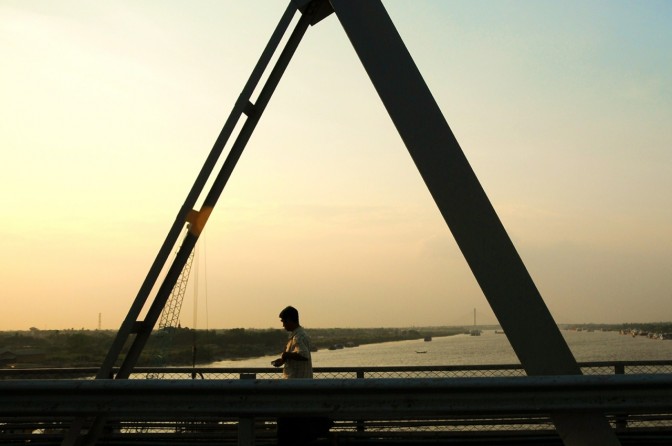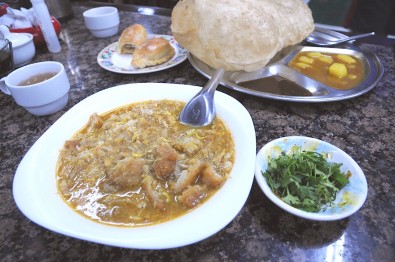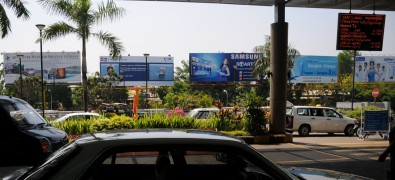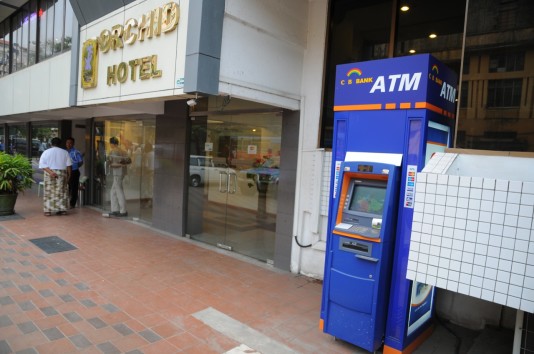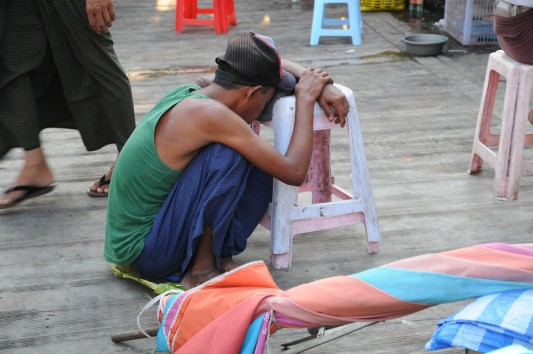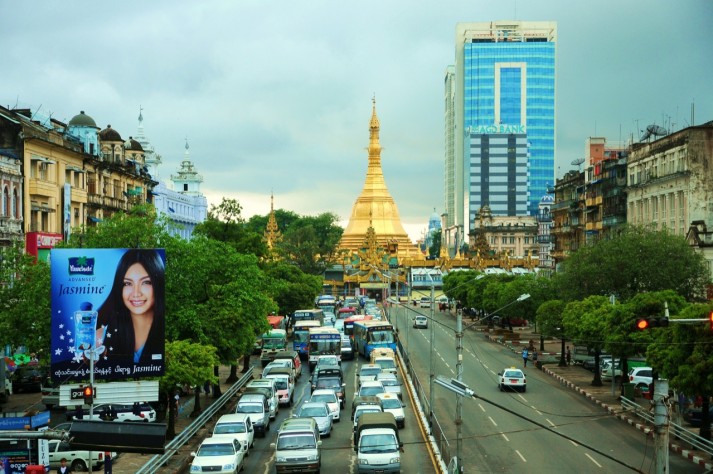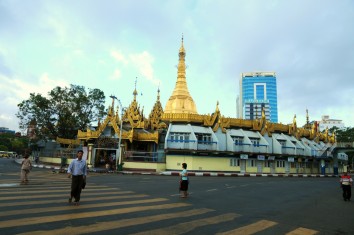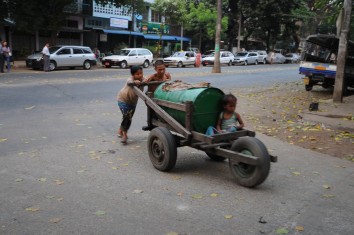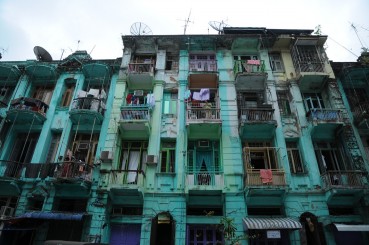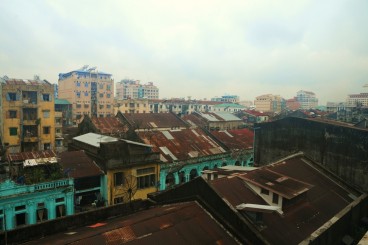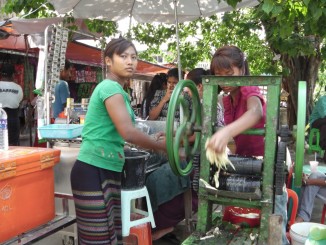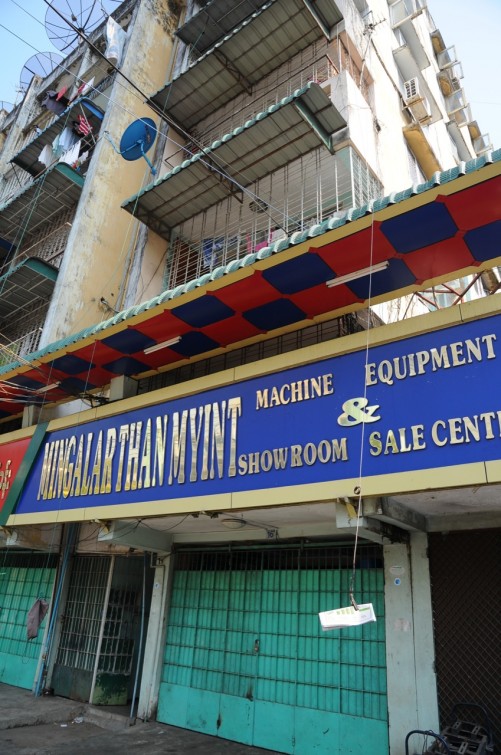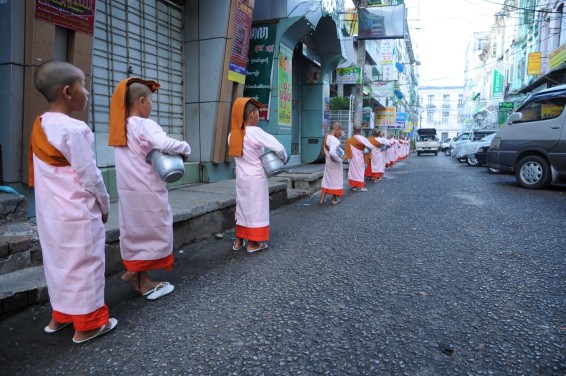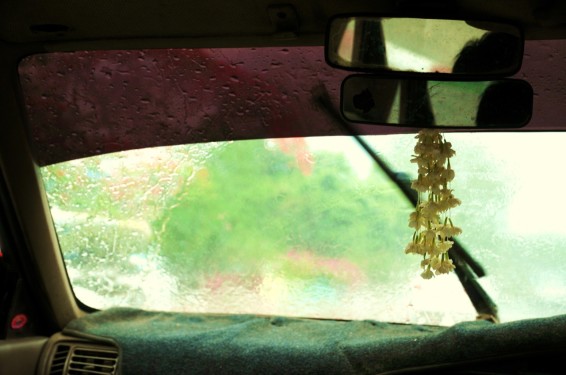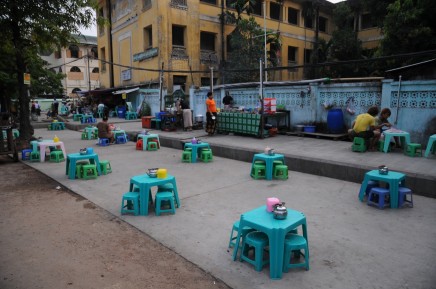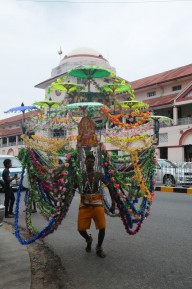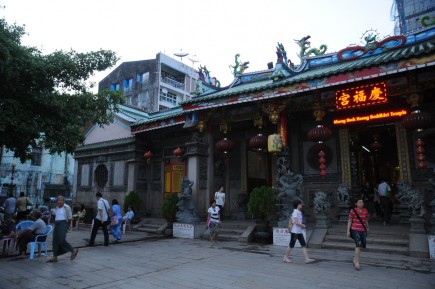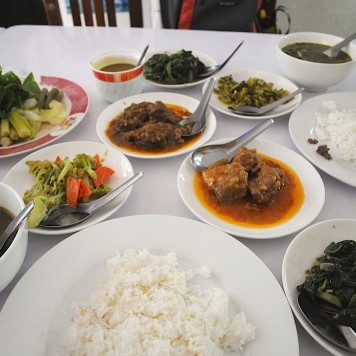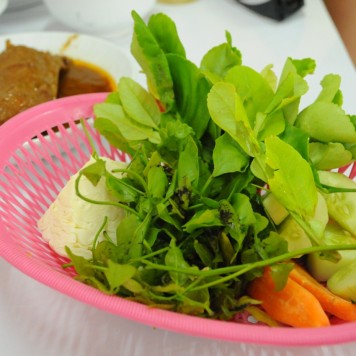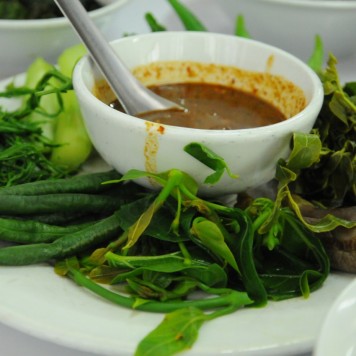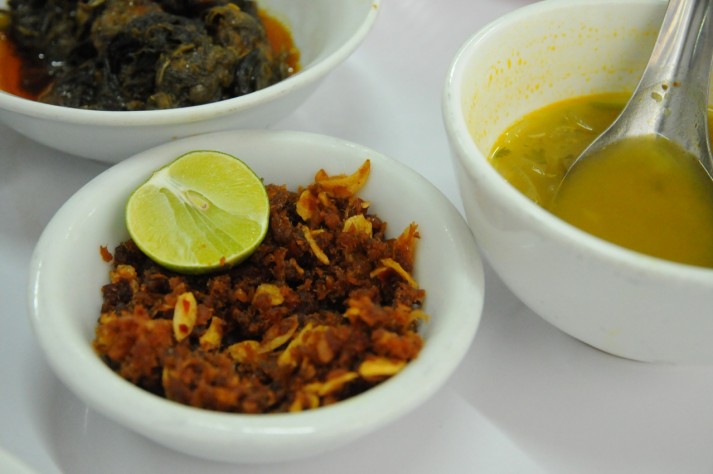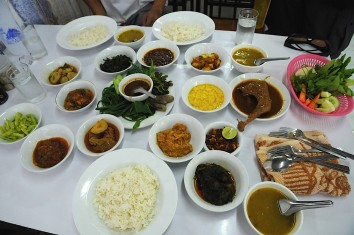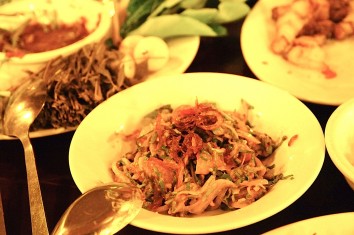Written by Yu-Jong Peng/Photoed by Yu-Jong Peng
When our flight was cruising over Moulmein and heading towards the broad and deep Andaman Sea, I finally pulled my thoughts away from thinking about our interviews and work plans. I glanced at the deep blue ocean outside of my small window from the airplane and saw the port city named Yangon afar. Instead of feeling anxious over the unknowns, I actually thought about the familiar smells near Huaxin Street in New Taipei City where I lived for the past three years. I thought about the fish ball soup noodle (mohinga) at Gong Mama, Burmese curry (h’in) with wild vegetable salad and fish sauce (ngapi) at Golden Peacock, pea flour porridge and rice noodle strips at Foreign Delight, Burmese salad (lethok) at New Moon, fermented tea leaves at Bago Taste, yogurt at Li Yuan Muslim Restaurant, palata/paratha ( Indian bread) with condensed milk tea in Rifa and Lantian restaurants, Indian rice (biryani or danbauk) with split pea soup (pehhin-ye) at Golden Diamond, sour cabbage soup (chinyah hin) and many other delicious dishes that I didn’t even know their names in Yunnan Buffet and all the other eateries on the street corners.
It was through tasting the food and looking at the maps of their hometowns in Myanmar hung on the walls in the restaurants that I began wondering about this mysterious country. I listened to them recount their past experiences such as encounters with ethnic conflicts or sufferings from anti-Chinese incidents. I listened to them naming all the cities, Bago, Taunggy, Moulmein, Mandalay, Taunggy, Mytikyaina, which, to me, sounded like someone saying a series of spells. I saw nostalgia in their eyes when they mentioned Shan State, the beauty of the Inle Lake, and Sen Ta Lone (meaning “a diamond”) known as the gift for the nobilities in the legend.
It was through the sense of taste and the feelings of nostalgia that I first came to learn about this land. It is twenty times bigger than Taiwan, located in between India, China, and Thailand, and made of one hundred and thirty five ethnicities. This type of complex engagement and convoluted feelings are far more real and full of human experience compared to the news and writings on opening and reform or on economic opportunities about Myanmar.
Just before the rainy season began in June, I finally stepped onto this land. I was welcomed by the hot wind of 42 degrees Celsius when the plane cabin door opened. For the following month, I did not stop even for a moment and sweated constantly.
Strolling in Yangon
Myanmar has three seasons: the rainy season is from June to October, the cold season (or dry season) from November to February, and the hot season from March to May. I arrived at the peak of the hot season, just a few days after the Thingyan (the Water Festival) of the New Year celebration. The whole city was still under extreme heat. I could hear the sound of the bells hung on the sugar can juicing machine by the vendors filling the streets like background music.
Compared to other cities in Southeast Asia or in India, Yangon was a relatively safe city for taking a leisurely stroll. Strolling around the Sule Pagoda in the city center or streets near Bogyoke Aung San Market, we saw scenes that made Yangon very similar to other cities in East Asia that had tried to play catch up. There were constructions everywhere, modern high rise in the midst of old British-style building from the colonial period, and sidewalks filled with large generators emitting smoke and loud noise in an attempt to provide electricity to a city that had been experiencing power outages frequently.
In terms of fashion, the influence of the West in Yangon was relatively mild. The majority of the people there, men or women, still wore traditional clothing – known as longyi. The main difference between the men’s and women’s clothing was that the tie was on the front of the waist for men while it was on the side for women. In terms of traffic, the chaos and jammed condition in Yangon was also very similar to those in other Asian cities but with an additional phenomenon of right-hand drive vehicle mixed with left-hand drive ones in a city generally followed right-hand traffic pattern (the same direction as it was in Taiwan). But judging from the crowdedness of this city, it was hard to tell that it had just come out of many years of dictatorship and bloody revolution.
I also saw many other familiar scenes in this city. For example, its streets were filled with food vendors with their small and low dining tables and chairs; there were lots of lottery-selling peddlers and countless betel nut stands (the way they consume it there is a little different from that in Taiwan, which I’ll describe later)! One could see bright red betel nut spits covering the ground everywhere and the red-stained mouths when some friendly Burmese gave a hearty laugh! For someone like me who was from Taiwan’s countryside, these were such familiar scenes!
Walking towards the west from Sule Pagoda along the Maha Bandula Road, the street number decreased from 30th to 29th and so on. Upon seeing a few Indian restaurants selling pulao rice and samosas, sweet stands on the side of the road, and some yogurt shops, we knew we had arrived the Little Indian area. This would be the area to dine if you feel like eating Southern Indian or Islamic food. Walking further west and passing the 21st street, we knew it was the Chinatown because of the shrines in Chinese style and the moon cake bakeries.
The ethnic diversity of Yangon created a plethora of ethnic cuisines there. However, the appearance of the Little India and Chinatown was not only a reflection of the immigration history but a reminder of the early British colonial policy that had conscripted and imported Indian and Chinese laborers in Myanmar’s past. The checkered street layout with numbered streets were also from the days of colonial city planning. All of these are reminiscent of Myanmar’s colonial history.
Let us temporarily put aside these heavy discussions. What does the most typical and representative Burmese food look like?
Burmese Cuisine
First of all, let’s talk a little bit about what I meant by “representative.” Myanmar is a country made up by multiple ethnic groups that influence each other. There are eight major ethnic groups (Bamar, Shan, Mon, Kayin, Kayah, Chin, Kachin, and Rakhine). Since Bamar is the one with the most population, their food is often considered to be representative. But just like how Han Chinese and Southern Ming food are often thought to be representative of Taiwanese cuisine, it is not to say that food of other ethnic groups are not representative.
Burmese curry (h’in) and high quality Indica rice (htamin) can be said to be the heart of Burmese food. This can be attested in the language that the Burmese use to greet each other. Just like how the Taiwanese greet each other by asking “Have you eaten?” the Burmese greet by asking either “Have you eaten lunch” (Sar pyi bi lar?) or “What curry did you have for lunch?” (bar bin ne sar le?).
If you walk into a typical medium to low price Burmese restaurant in Yangon (Myanmar saa thauk sain), such as Danuphyu Daw Saw Yee on the 29th street, you will see a large display of food consisted of a variety of Burmese curry and a selection of side dishes. Burmese curry looks greasy and shiny and usually comes in a variety of choices including beef, lamb, pork, chicken, shrimp, fish, and egg and vegetable for vegetarians. You can choose as many or as few flavors as you want. Side dishes are usually different types of vegetable blanched or stir-fried. The price depends on your selection. After you make the selection and return to your seat, the waiters in the restaurant will bring Chinese-style hot tea to your table.
This type of Burmese restaurant does not serve dishes in a particular order like what a western-style restaurant would such as serving the appetizer first and then the main course. It is more common that everything comes out at the same time. So on your table, you will find the main curry dish that you have ordered, a large plate of long-grain rice, side dishes, complimentary vegetable stew soup (hinjo or pickled vegetable soup known as chinyay hin), fried shredded shrimp, cold salad dish (tozaya) and dipping sauces (usually the very pungent fish sauce known as ngapi ye). Not only the shiny yellow color of the curry matches well with the grassy green of the pickle soup making it an appealing display, the abundance of vegetable makes the meal look very refreshing.
Don’t be fooled by the greasy look or the deep color of the Burmese curry. Actually, Burmese curry is not as spicy as Indian or Thai curries. It has fewer spices compared to Indian curry, and it rarely uses coconut milk, green pepper, or sugar like the Thai curry does. The thick layer of oil on top of Burmese curry comes from a unique cooking method known as s’ipyan (its meaning is close to “settle of the oil”)
S’ipyan means to first mix and cook thoroughly all ingredients for curry and spices (see notes below) and with marinated meat and carrier oil (peanut or sesame oil from dry area of Upper Myanmar region). Then, simmer it using low heat until the water is evaporated and the oil is forced to rise to the top and becomes clear. According to some cooking recipes and what I have found out consulting several Burmese restaurants, the purpose of s’ipyan is to allow the flavors of all the ingredients, such as onions, turmeric, cumin, ginger, garlic and so on, to mix thoroughly and blend together. It also lowers the spicy level to the taste and smell. The oil layer on the surface perhaps helps separate the curry from air and bacteria, which helps extend the shelf-life in Myanmar where electricity and refrigeration are not reliable. (Notes: A basic Burmese curry usually contains ground onion, hot pepper, turmeric, ginger, cumin, gekkei leaves, and garlic; the more sophisticated version can have cardamom, fenugreek, dried clove, coriander seeds, mustard, pepper, nutmeg, cinnamon, shrimp paste, and poppy seeds; fresh green leaf includes cilantro,curved-leaf wampee, chives, lemon grass, grapefruit peel, kaffir lime leaf, etc.)
What Burmese eat is an important topic of discussion; but the Burmese also enjoy their food in their own style. I went to Aung Thukha restaurants on the northern side of the city and sat together with the locals in Yangon on the low tables for the meal (we only sat on chairs instead of the more traditional option of the bamboo mats). On the table were pickled tea leaves (lephet) held in a lacquer ware hand-made by artisans from Bagan. I took a taste of it and the tastes of fermented tea leaves, sesame, fried beans, shredded shrimp, shallots, peanuts and all kinds of spices magically melted together in my mouth. It may be said that the deep impression this tropical city has made on me is captured in my bite of the pickled tea leaves: strange but with a balanced taste of sourness, sweetness, bitterness, and saltiness.
[shareaholic app=”share_buttons” id=”6826179″]
